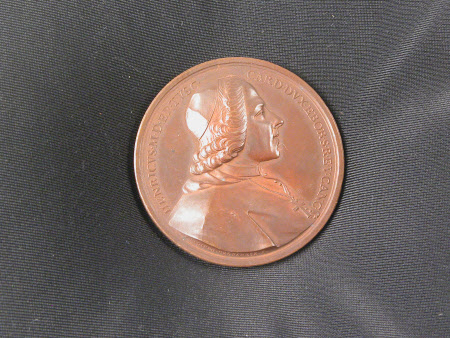Prince Henry, Cardinal Duke of York, on the death of Prince James (King James VIII and III)
Filippo Cropanese (fl.1756 - 1773)
Category
Coins and medals
Date
1766
Materials
Copper
Measurements
52 mm (Diameter)
Place of origin
Rome
Order this imageCollection
Osterley Park and House, London
NT 773275
Summary
Copper, Prince Henry, Cardinal Duke of York, on the death of Prince James (King James VIII and III), by Filippo Cropanese (fl. 1756-1773), struck Rome, Italy, 1766. A copper medal by Filippo Cropanese depicting Henry Benedict Stuart, Cardinal Duke of York (1725-1807), commissioned following the death of his father Prince James (James VIII and III; The Old Pretender, 1688-1766). On the obverse the Cardinal depicted facing right in ecclesiastical vestments, a cross on a chain around his neck. The Latin legend translates as: ‘Henry, by the mercy of God, Bishop of Tusculum, Cardinal, Duke of York, Vice-Chancellor of the Holy Roman Church’. The artist’s signature on the truncation of the bust. The reverse depicts an allegorical figure of Piety standing, a Cross and book in her hand, to her sides a lion, cardinal’s hat and a crown. In the distance are St. Peter’s and a view of the Tiber. Legend translates as: 'Not by the desires of men, but by the will of God.’ The exergue bears the date, 1766.
Full description
Henry Benedict Stuart was the younger brother of Prince Charles Edward Stuart, the Young Pretender and, as such, the second-in-line to the throne according to supporters of the Jacobite cause. Prince Henry Benedict became cardinal-deacon of the Catholic church in 1747, a year after the defeat of Bonnie Prince Charlie at Culloden, going on to enjoy a successful career within the church. On 1 September 1748, he was ordained a priest, removing any final hopes that he might marry and produce heirs. In 1758 Henry was created Cardinal York and Chamberlain of the Sacred College of Cardinals and, in 1761, Cardinal-Bishop of Frascati. Prince Henry’s decision to enter the hierarchy of the Catholic church reflected his belief, as well as that of his father King James VIII and III (‘The Old Pretender’), that the opportunity for restoration had passed and that, with the defeat at Culloden, the Jacobite cause had been lost. This was not the opinion of Henry’s brother Charles, who regarded his sibling’s move as a betrayal of himself as well as the Jacobite cause more broadly, since such a close affiliation to the Papacy meant that the Stuart claim could not realistically be pursued by Prince Henry. Despite his semi-official disavowal of his claim to the throne, the Cardinal Duke of York continued nevertheless after his brother’s death to be known privately as King Henry IX. The medal was commissioned by Henry following the death of his father, Prince James, on 1 January 1766. The disconsolate lion on the reverse may be intended to symbolise a grieving Britain. Henry’s older brother Prince Charles continued fiercely to espouse the Jacobite cause and remained estranged from his more resigned and by now tolerant father until the latter’s death. Henry on the other hand, sharing his father’s views, probably commissioned the medal in order to demonstrate that his path was now realistically that of the Church, not Jacobite politics. The medal served as the basis for the 1788 medal by Gioacchino or Giovanni Martino Hamerani (NT 773313 and NT 773315) commissioned by the Cardinal Duke of York after his brother’s death. An example in the National Gallery of Art, Washington has the portrait signed by Cropanese on the obverse, but the Hamerani’s 1788 version of the reverse. It is a so-called mule, a medal created from the obverses and reverses of different medals. Jeremy Warren 2019
Provenance
Given to the National Trust in 1993 by George Child Villiers, 9th Earl of Jersey (1910-1998).
Marks and inscriptions
Obverse, legend: HENRICVS. M. D. EP. TVSC. CARD. DVX. EBOR. S. R. E. V. CANC. Obverse, below truncation: FILIPPO. CROPANESE. F. Reverse, legend : NON. DESIDERIIS. HOMINVM. SED. VOLVNTATE. DEI. Reverse, exergue: AN. MDCCLXVI.
Makers and roles
Filippo Cropanese (fl.1756 - 1773), medallist
References
Cochran-Patrick 1884: Robert William Cochran-Patrick, Medals of Scotland from the earliest period to the present time, Edinburgh 1884, p. 75, no. 63, Pl. XIV, Fig. 6. Skeet 1930: Francis John Angus Skeet, Stuart Papers, Pictures, Relics, Medals and Books in the Collection of Miss Maria Widdrington, Leeds 1930, p. 76. Brown 1980: Laurence Brown, A catalogue of British historical medals 1760-1960, Vol.I. The accession of George III to the death of William IV, London 1980, p. 24, no. 99. Woolf 1988: Noel Woolf, The Medallic Record of the Jacobite Movement, London 1988, p. 124, no. 67:1. Pollard 2007: John Graham Pollard, Renaissance Medals. National Gallery of Art, Washington, 2 vols., Washington 2007, vol. II, p. 827, no. 862. Eimer 2010: Christopher Eimer, British Commemorative Medals and their Values, London 2010, p. 111, no. 715, pl. 81.

